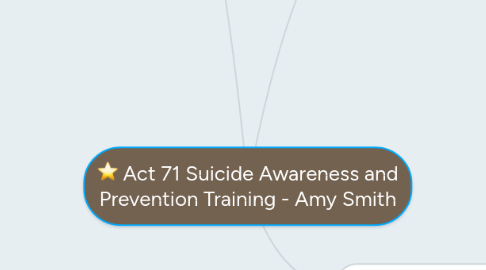
1. Evidence 1: Risk Factors
1.1. Environmental
1.1.1. Prolonged bullying, relationship problems, or harassment
1.1.1.1. The school environment can be particularly hard on students who are exposed to bullying and harassment, which could lead to depression or mental health issues.
1.1.2. Problems in the school environment - struggling academically/think teachers do not care/poor relationships with peers
1.1.2.1. Students who are consistently told that they are not doing well enough in school may be at risk because they are looking for a way out of school.
1.1.3. Home environment - access to firearms/drugs without parental supervision
1.1.3.1. If substances and/or weapons are not monitored by parents, students who are already at risk may have an easier way to commit or plan a suicide.
1.1.4. Exposure at home/school/etc. to another person's suicide or attempt(s)
1.1.4.1. People who are exposed to other suicides/attempts may be thinking about suicide more, and may be more likely to attempt themselves.
1.1.5. Lack of parent support, high levels of conflict/violence in family, alienation from family or home life
1.1.5.1. If the home environment is not adequate or supportive, students may be at risk for suicide because of mental health issues.
1.2. Biological/Psychological
1.2.1. Mental heath disorders (schizophrenia, antisocial personality disorder, anxiety)
1.2.1.1. Mental health disorders can cause impaired judgement and may lead to rash decision making, which puts students at a higher risk of suicide.
1.2.2. Substance abuse disorder
1.2.2.1. Similar to mental health disorders, substance abuse can lead to rash decision making.
1.2.3. Serious health condition/life-threatening condition/chronic pain
1.2.3.1. People with pain or life-threatening conditions may look for an easier way out.
1.3. Historical
1.3.1. Personal history of suicide attempts
1.3.1.1. People with a history of suicide attempts are 8 times more likely to commit suicide, so they are a very high risk group.
1.3.2. Family history of suicide attempts
1.3.2.1. Students who are exposed to suicide in their family are likely to have suicide on their mind, and should be considered at risk.
1.3.3. Changes in family structure (death, divorce, move, financial instability, sexual or physical abuse)
1.3.3.1. Abrupt changes in a child's personal life can be distressing, and may lead to suicidal thoughts.
1.3.4. Self-mutilation (cutting, burning, biting, etc.)
1.3.4.1. Self-mutilation can (but not always) be linked to suicide attempts. In any case, it indicates issues that the student should get help for.
2. Evidence 3: Action Steps
2.1. Remain calm and listen
2.1.1. Don't panic or give up hope. If a student opens up, he/she trusts me and it is important to keep that trust. Listen to the student talk and try to understand the student's point of view. Provide reassurance without minimizing the student's problems.
2.2. Don't leave the student alone
2.2.1. Someone needs to keep a constant watch on the student. Try to keep the student talking about himself/herself and their feelings. Involve parents/counselor/principals/nurse to help monitor the student.
2.3. Ask questions
2.3.1. Is the student having suicidal thoughts? Have they formulated a plan? Do they have the materials that they need to carry out the plan? Is there a time planned to carry out the plan? If the answers to these questions are "yes," it is important to involve other adults and not try to solve problems for the student by myself.
3. Evidence 2: Warning Signs
3.1. Warning Signs
3.1.1. Isolation: Withdrawing from activities and schoolwork (could be linked to depression)
3.1.2. Acting recklessly and aggressively, or seems to be more irritable (sudden changes in behavior)
3.1.3. Seems to be preoccupied with death: saying goodbye, giving important personal items away, or talking about how things will be when they are gone
3.1.4. Using alcohol/drugs and making destructive decisions that are not characteristic
3.1.5. Talks to people about suicide, or even potential suicide plans, or talks about feeling trapped and looking for ways out
3.2. Quotations
3.2.1. "90% of people who die by suicide have a mental disorder at the time of their deaths." (Reading 1)
3.2.1.1. We seem to see many warning signs and/or risk factors linked to depression and other mental illnesses. This statistic goes to show how important it is to be extra supportive to students who fall into the category of having a mental disorder.
3.2.2. "The recent advent of social media has provided another outlet in which warning signs may be exhibited." (Reading 4)
3.2.2.1. As a high school teacher, social media is ever-prominent and there is no way to stop that. We need to be talking to our students about appropriate ways to use social media, and to do our best to be preventing cyber bullying. We also need to make students aware that they are not "tattling" on students who may post about suicide or other warning signs, and that going to an adult can save a peer's life.
